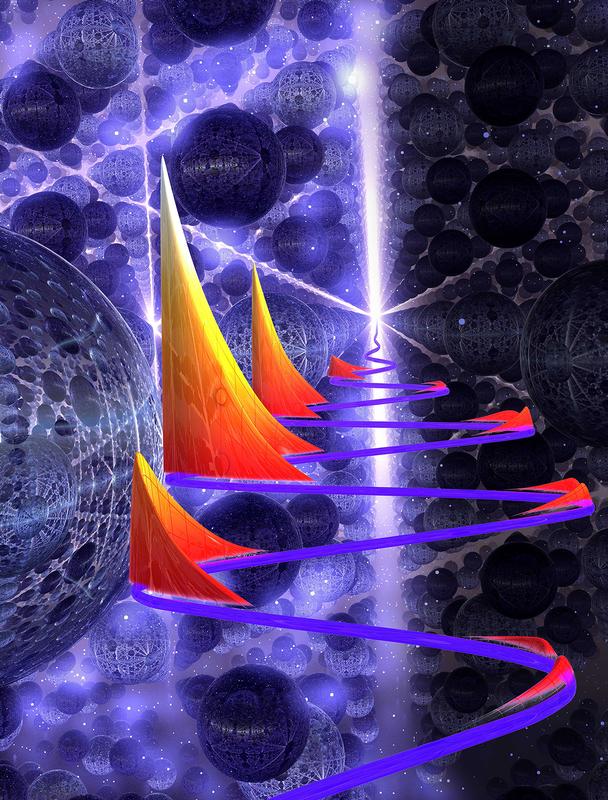
Electronics Breakthrough: Gigahertz Clock Rates Explained

An intense lightwave drives ultrafast electronic motion in a bulk crystal. A novel quantum interference creates free electrons and causes the emission of ultrashort high-harmonic light bursts.
Image: B. Baxley (parttowhole.com)
The advent of ever faster electronics featuring clock rates up to the multiple-gigahertz range has revolutionized our day-to-day life. Researchers and engineers all over the world have racked their brains about one central question:
Is there a fundamental limit for the speed of electronics? Indeed, all electronic circuits rely on charge motion controlled by electric fields. Future high-speed electronics would, therefore, benefit immensely from bias fields that switch faster than state-of-the-art electronic clocks. The solution to this challenge may be surprisingly straightforward: One could try to employ the fastest alternating electric field available in nature – a light wave.
The team of researchers from Germany has now directly observed the electrons’ motion in a semiconductor driven by a strong light pulse in the terahertz spectral region. The pioneering experiment carried out in Rupert Huber’s group at the University of Regensburg enabled the first simultaneous clocking measurement of extremely broadband radiation sent out by the accelerated electrons, so-called high-order harmonics, and the driving light wave.
It turns out that the harmonics are emitted in ultrashort light bursts which have now been characterized with a temporal resolution of approximately one femtosecond – the millionth of a billionth part of a second. In combination with numerical simulations performed in the groups of Mackillo Kira and Stephan W. Koch at the University of Marburg, this study provides unprecedented insights into the quantum world of a solid.
The results shed light onto a surprising behavior of the crystal electrons: During an extremely short timespan after excitation, the strong light field drives an electron simultaneously along multiple paths instead of one only. This strange scenario is possible in the quantum world where particles can behave like waves.
As an indisputable quantum wave aspect, the electrons were shown to interfere constructively (destructively) only at the positive (negative) crests of the driving field, massively reshaping the temporal emission of the harmonics. While such quantum effects are often fragile and usually become observable only in extremely gentle fields the newly discovered phenomenon is qualitatively different because it is robust, producing pronounced interference contrast especially for extremely strong driving fields.
The breakthrough reveals the temporal structure of high-harmonics from a solid for the first time and thus helps the development of new sources of ever shorter light pulses. Moreover, this discovery opens new perspectives for modern high-speed electronics and sets an important milestone on the way towards light-wave-driven electronics.
Original publication:
M. Hohenleutner, F. Langer, O. Schubert, M. Knorr, U. Huttner, S. W. Koch, M.Kira und R. Huber, Real-time observation of interfering crystal electrons in high-harmonic generation, Nature (2015), DOI: 10.1038/nature14652
Publication: http://dx.doi.org/10.1038/nature14652
Contact:
Prof. Dr. Rupert Huber
Universität Regensburg
Universitätsstraße 31
93053 Regensburg
Germany
E-Mail: rupert.huber@physik.uni-regensburg.de
Prof. Dr. Mackillo Kira
Philipps-Universität Marburg
Renthof 5
35032 Marburg
Germany
E-Mail: mackillo.kira@physik.uni-marburg.de









![[Figure 1] Schematic of next-generation CNT-PANI composite fiber supercapacitor and comparison graph with recent results](https://www.innovations-report.com/wp-content/uploads/2025/05/KIST_leads_next-generation_energy_storage_technolo_1746783279-e1746784635527-362x245.jpg)


